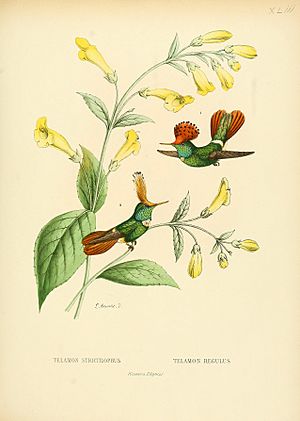Rufous-crested Coquette facts for kids
Quick facts for kids Rufous-Crested Coquette |
|
|---|---|
 |
|
| Male, on the right | |
| Conservation status | |
| Scientific classification | |
| Kingdom: | |
| Phylum: | |
| Class: | |
| Order: | |
| Family: | |
| Genus: |
Lophornis
|
| Species: |
L. delattrei
|
| Binomial name | |
| Lophornis delattrei Lesson, 1839
|
|
The Rufous-Crested Coquette (Lophornis delattrei) is a tiny and colorful species of hummingbird. It is known for its bright feathers, especially the male's fancy crest. You can find these beautiful birds in parts of Central and South America, flying through forests and woodlands.
Contents
About the Rufous-Crested Coquette
The Rufous-Crested Coquette is a small bird, part of the hummingbird family. It gets its name "coquette" because of the male's special, often colorful, head feathers. These birds are very active and spend most of their day looking for food.
What Does It Look Like?
The male Rufous-Crested Coquette is quite striking. It has a bright, reddish-brown crest on its head. Its body is mostly green, with some white and purple markings. The female looks a bit different. She has less bright colors and does not have the fancy crest. Both males and females are very small, like most hummingbirds. They have long, thin beaks perfect for sipping nectar.
Where Does It Live?
This amazing hummingbird lives in several countries. You can find it in Bolivia, Colombia, Costa Rica, Ecuador, Panama, and Peru. It prefers to live in warm, wet places. These include lowland forests and mountain forests. It can also live in areas where forests have been changed by people.
What Does It Eat?
Like other hummingbirds, the Rufous-Crested Coquette mostly eats nectar. Nectar is a sweet liquid found in flowers. They use their long tongues to reach deep into flowers. This helps them get the energy they need to fly so fast. They also eat tiny insects. Insects give them important protein.
How Does It Fly?
Hummingbirds are famous for their amazing flying skills. The Rufous-Crested Coquette can hover in mid-air. It can also fly backward and sideways. Its wings beat incredibly fast, making a humming sound. This special way of flying helps it get nectar from flowers. It also helps them escape from predators.
Life Cycle and Reproduction
Rufous-Crested Coquettes build very small, cup-shaped nests. They often use plant fibers and spider silk. The female usually lays two tiny white eggs. She takes care of the eggs and the young birds by herself. The baby birds grow quickly. Soon, they are ready to fly and find their own food.
Images for kids
-
In Panama
See also
 In Spanish: Coqueta crestirrufa para niños
In Spanish: Coqueta crestirrufa para niños



